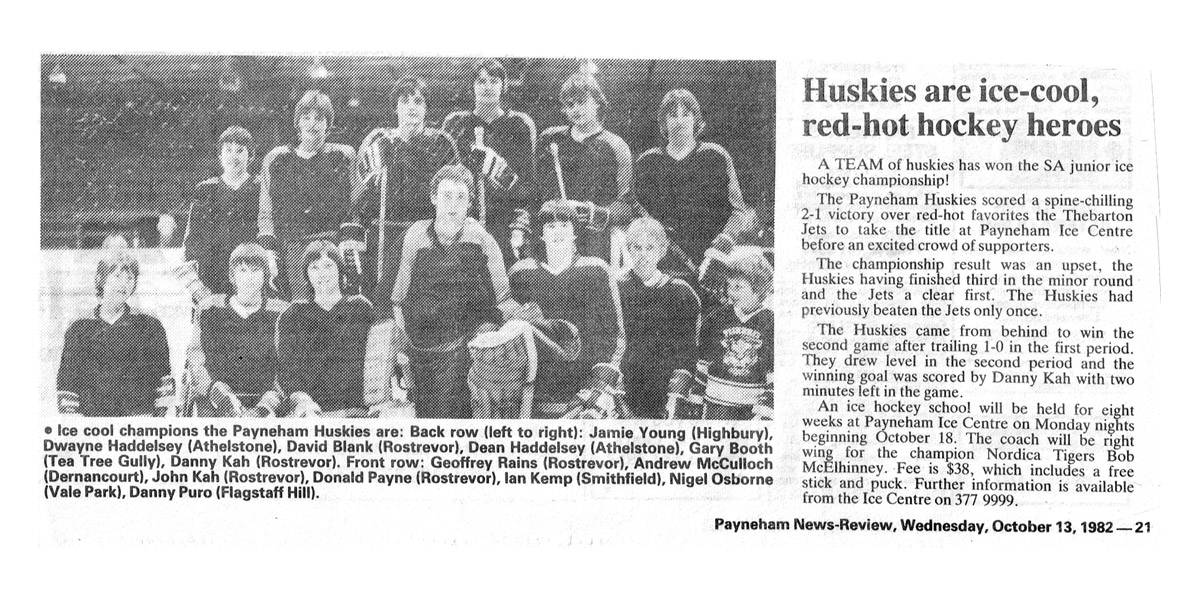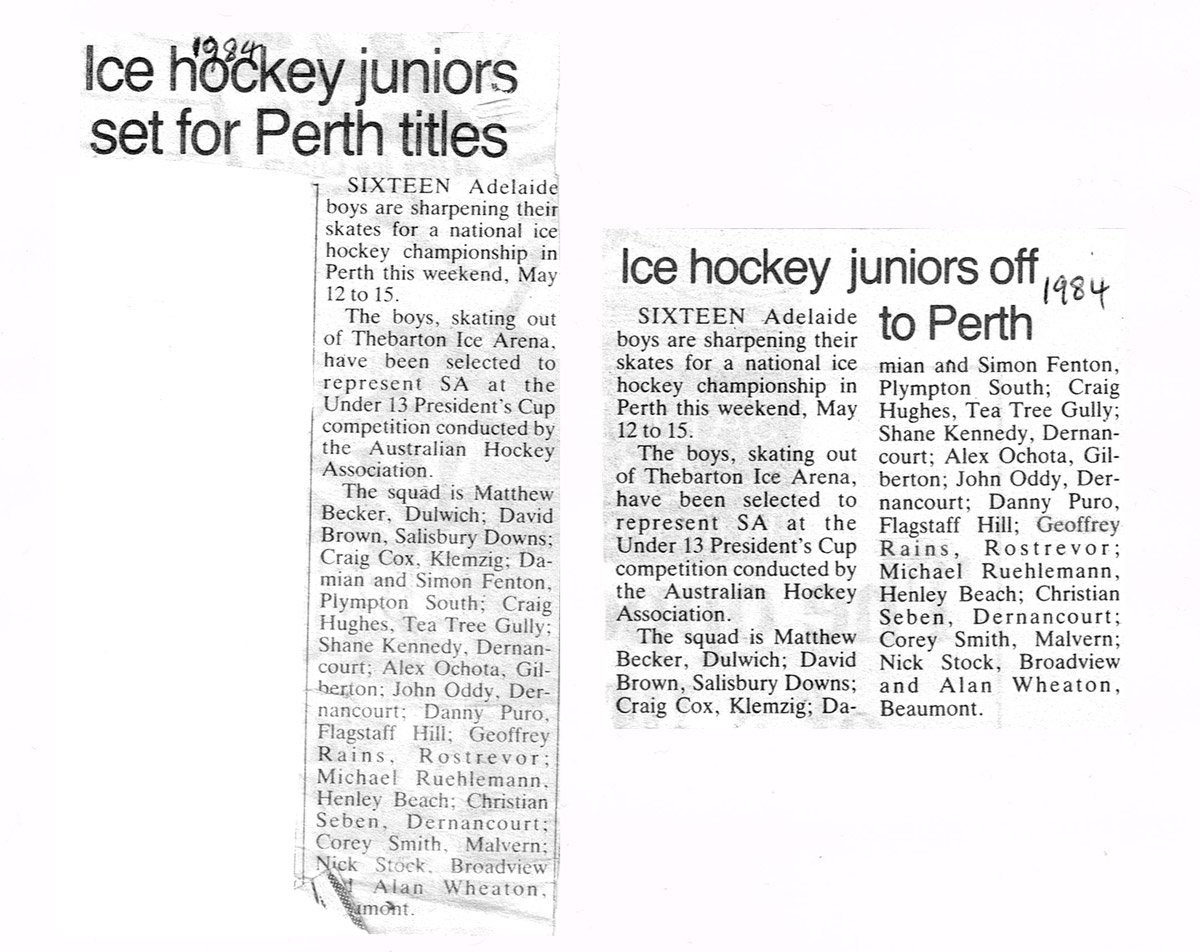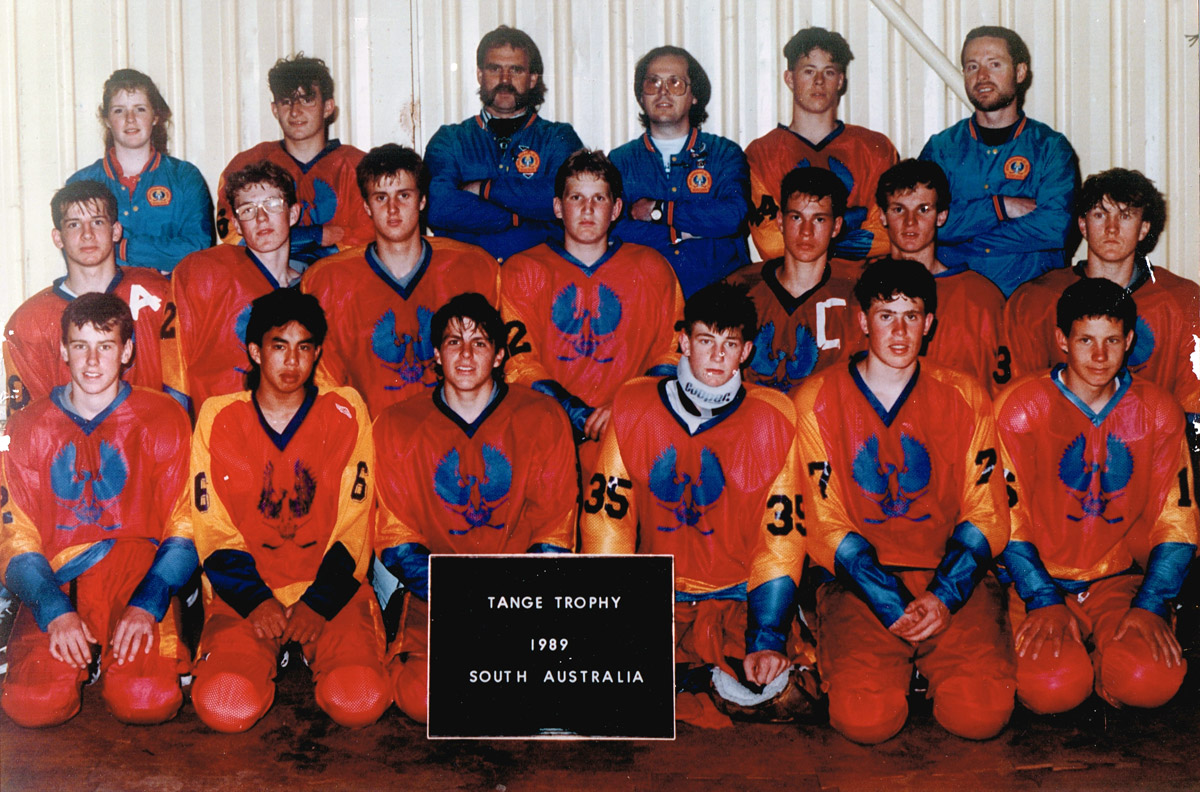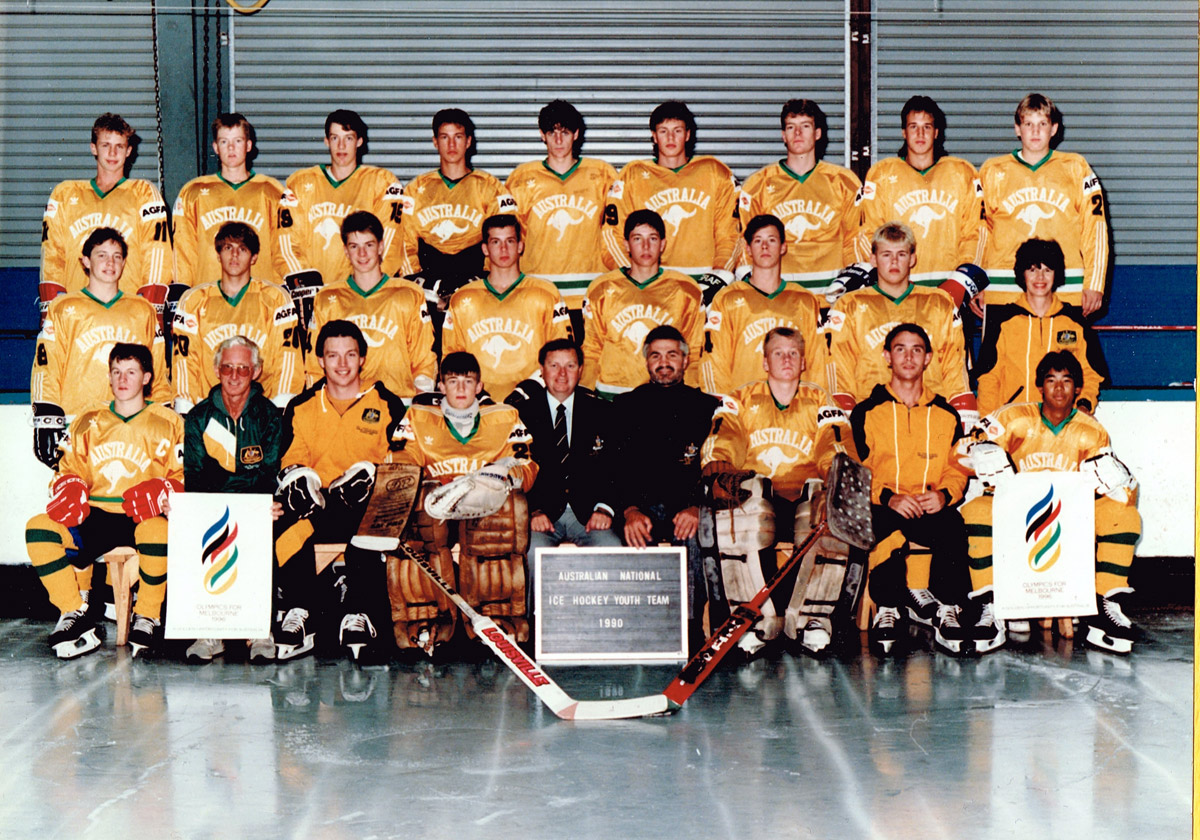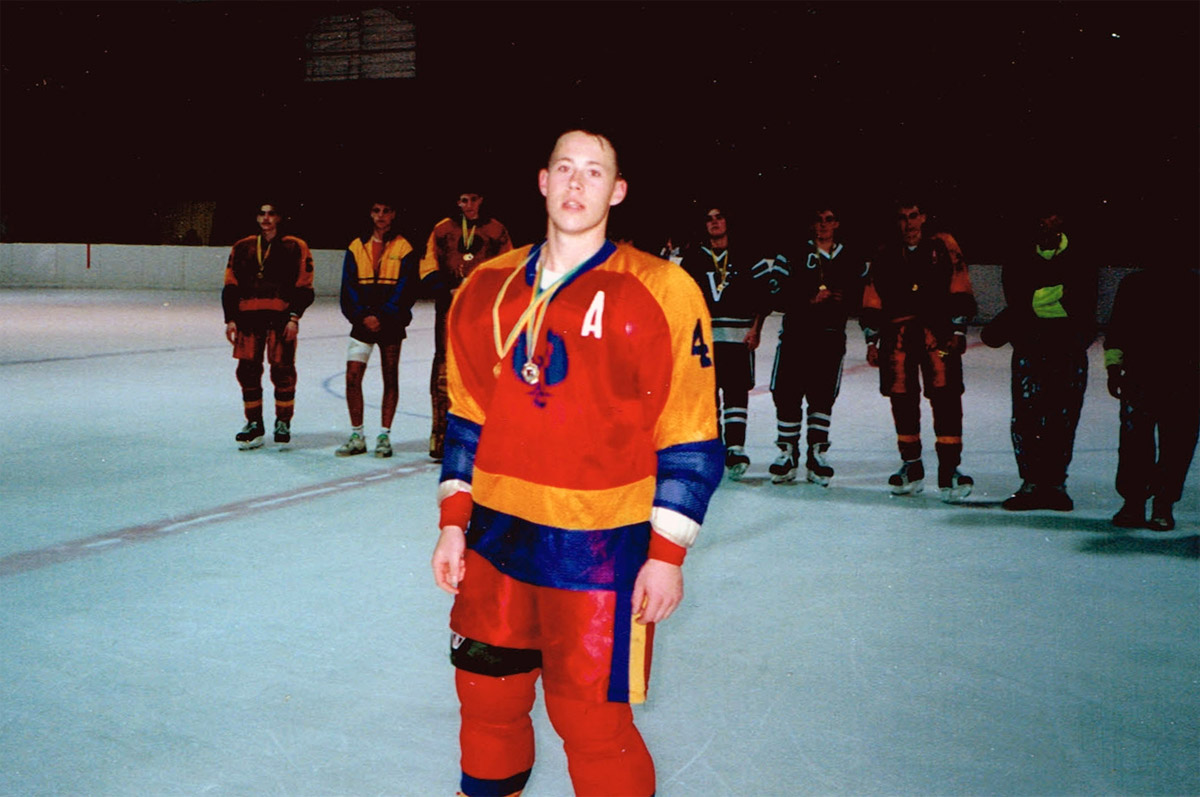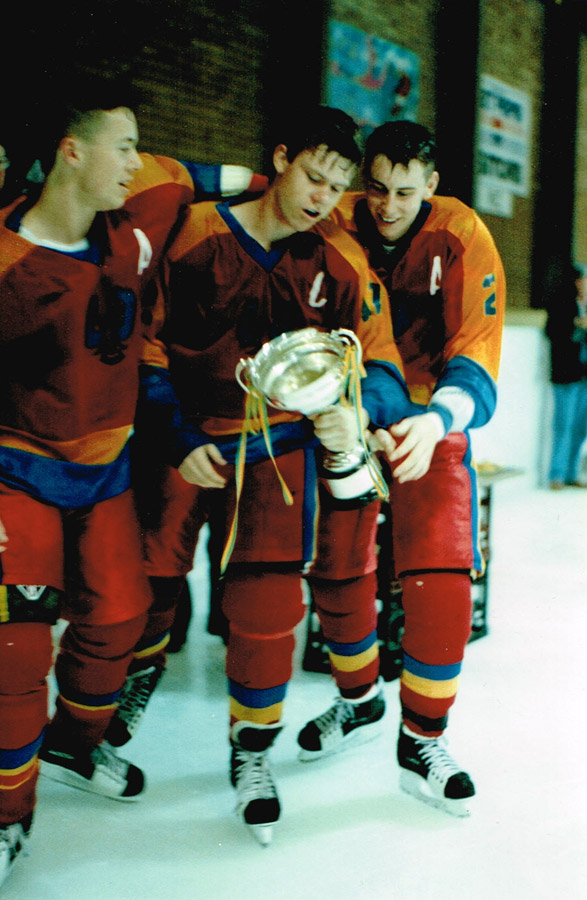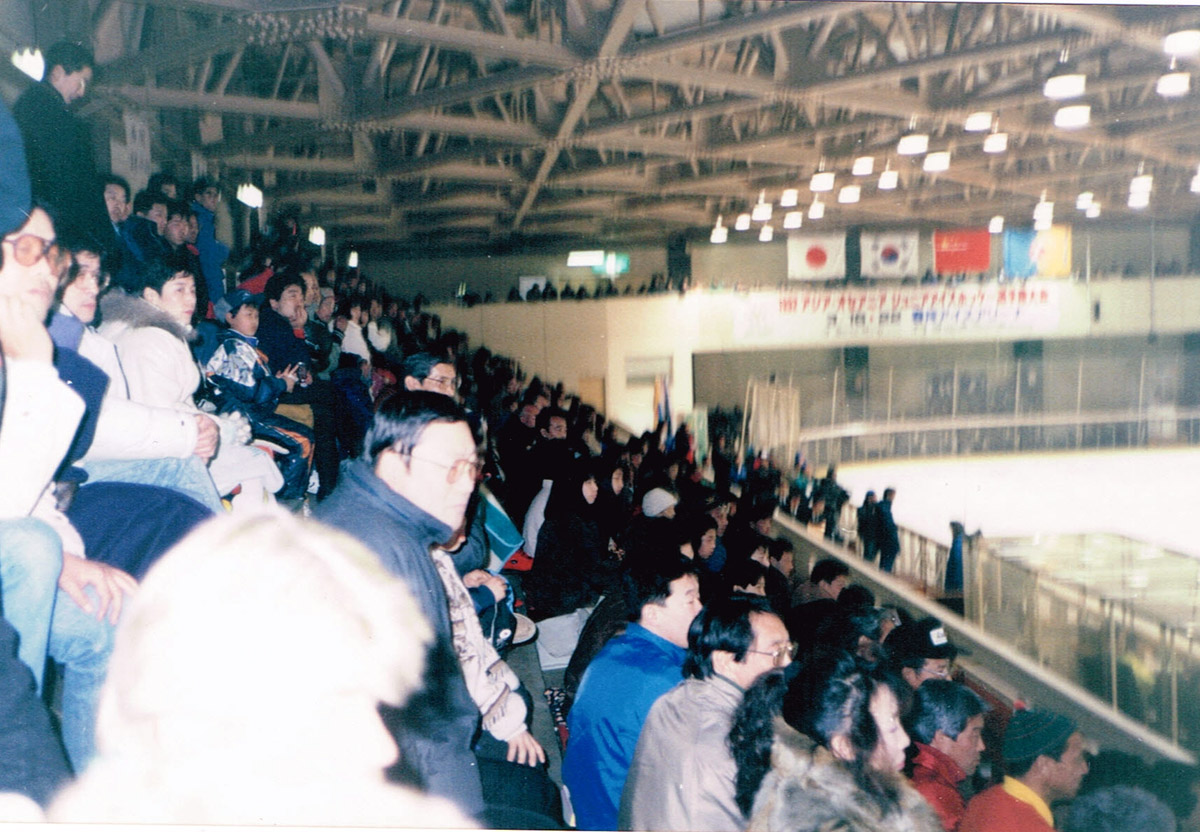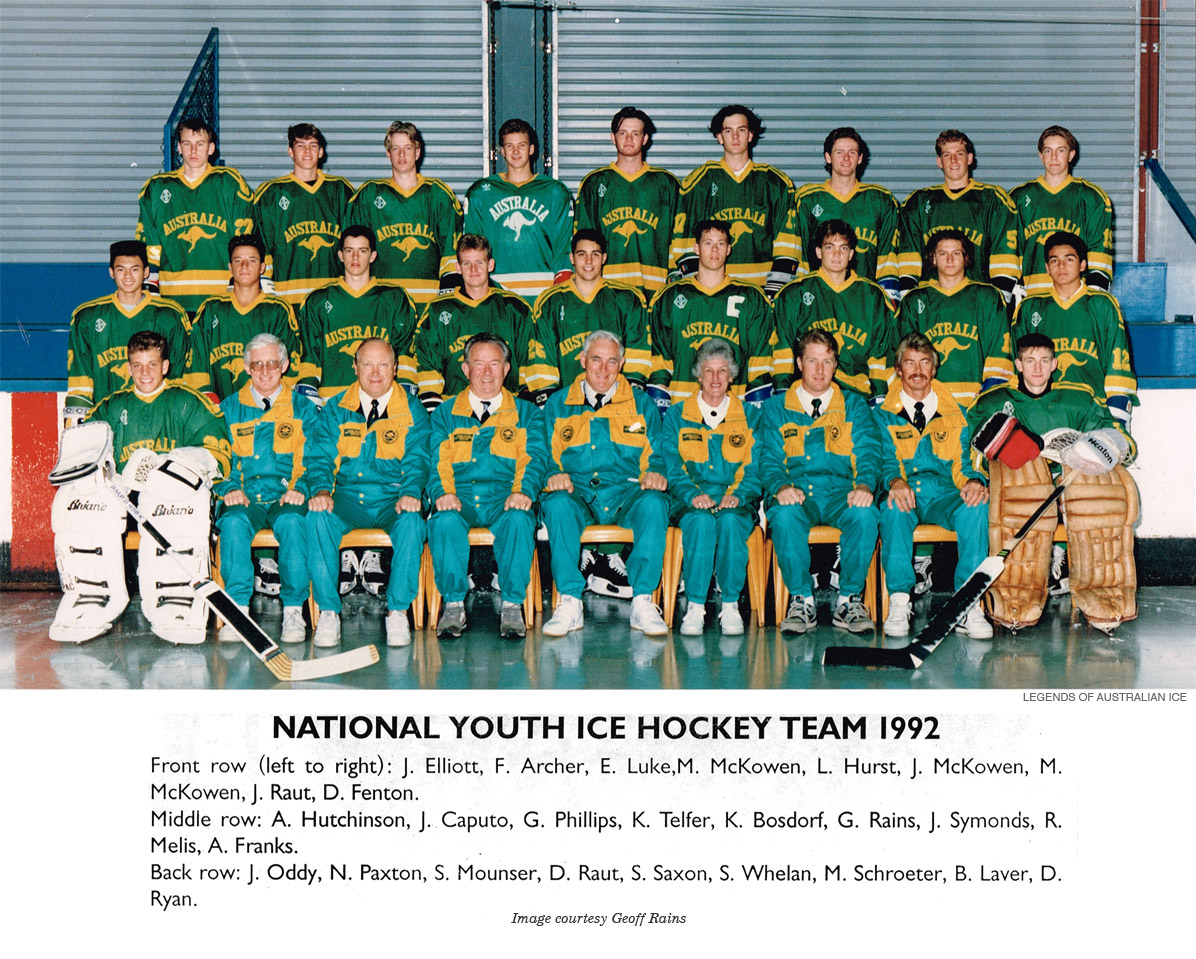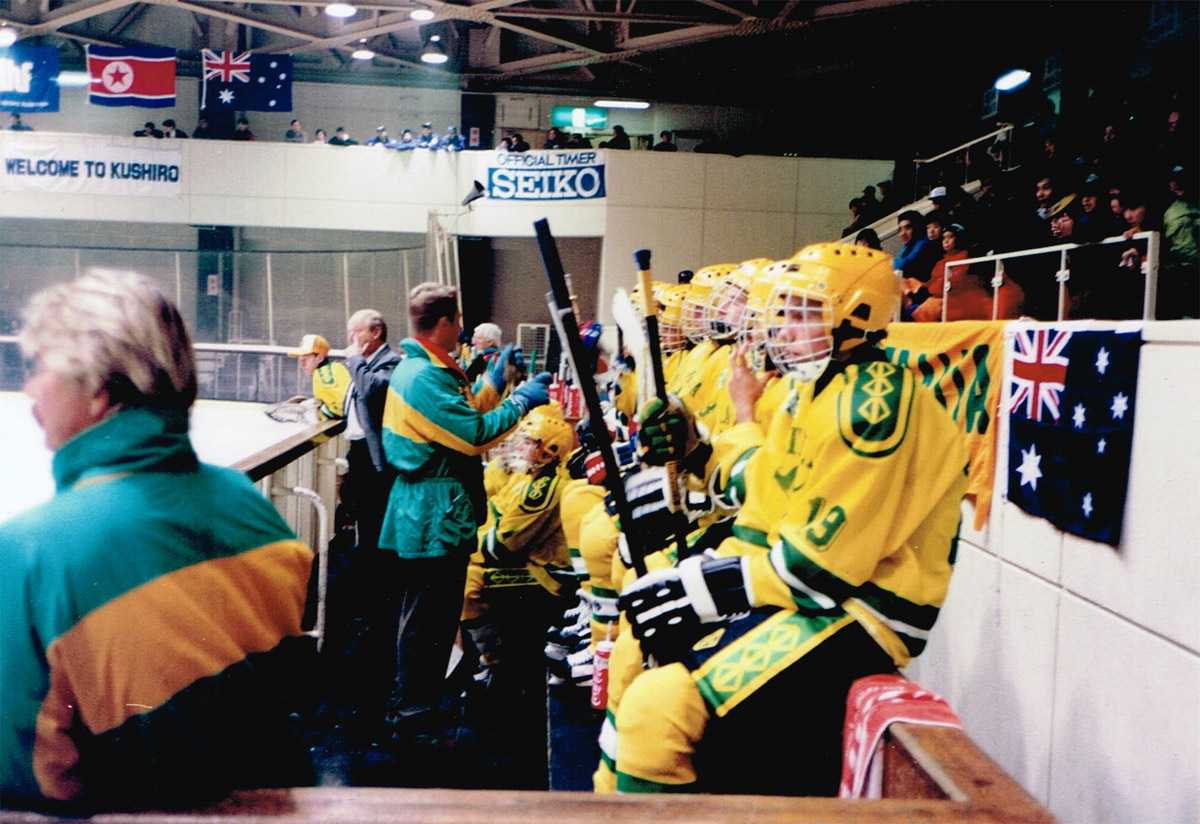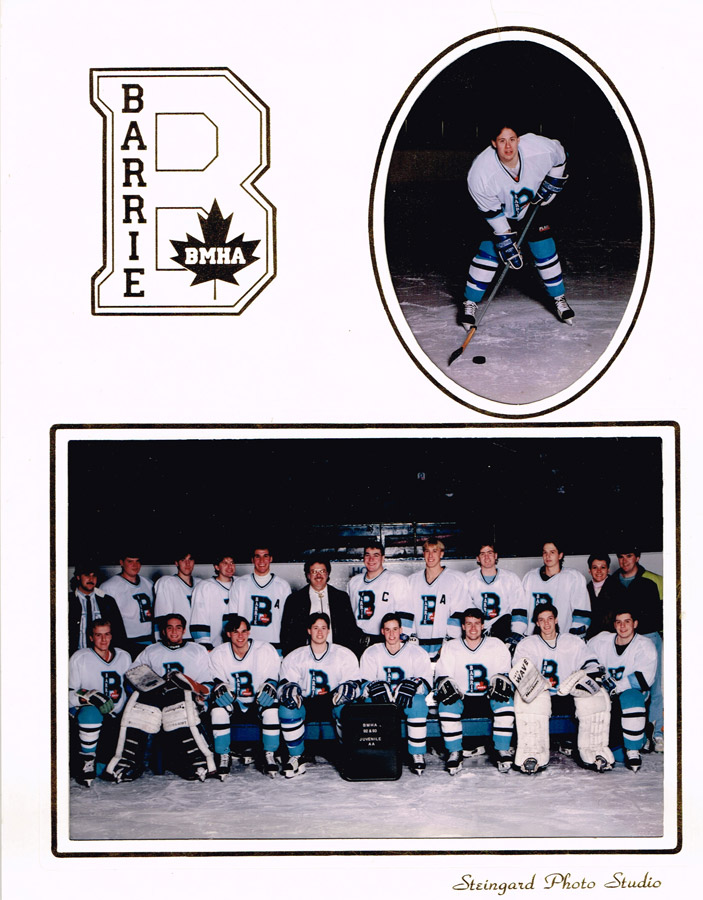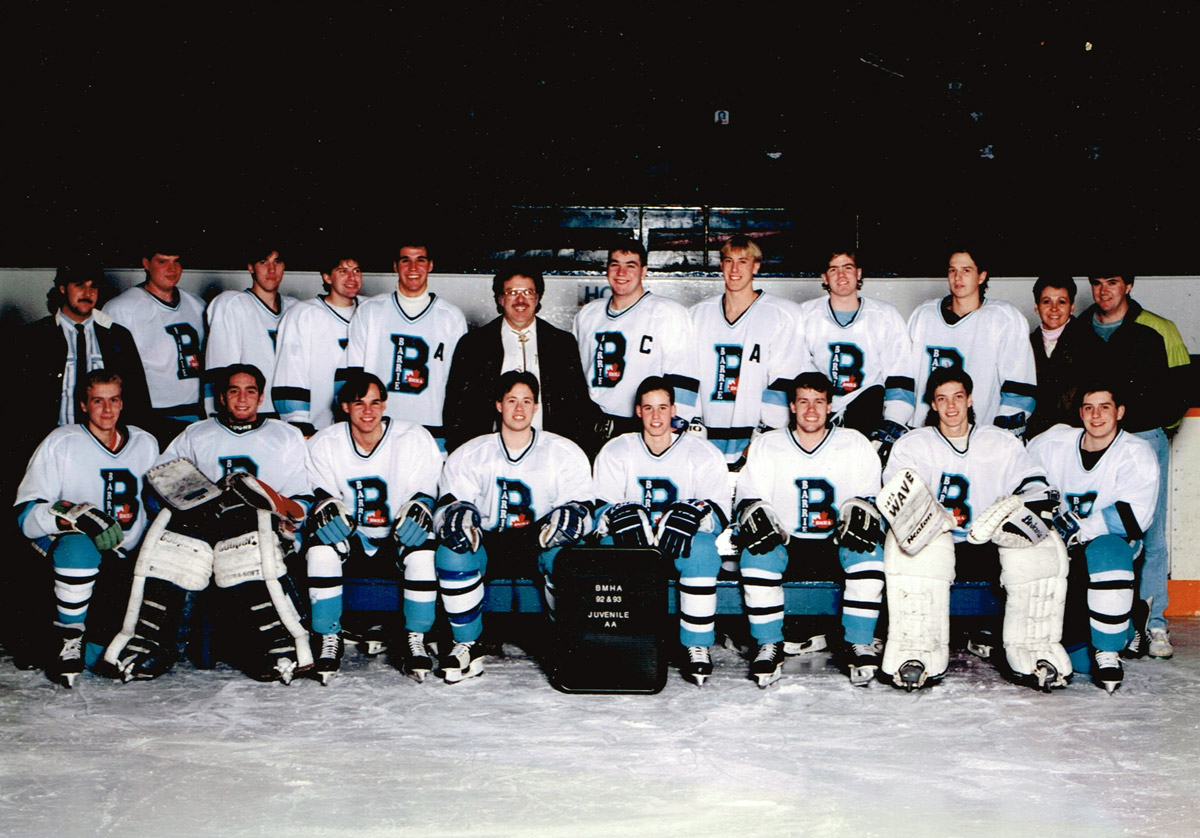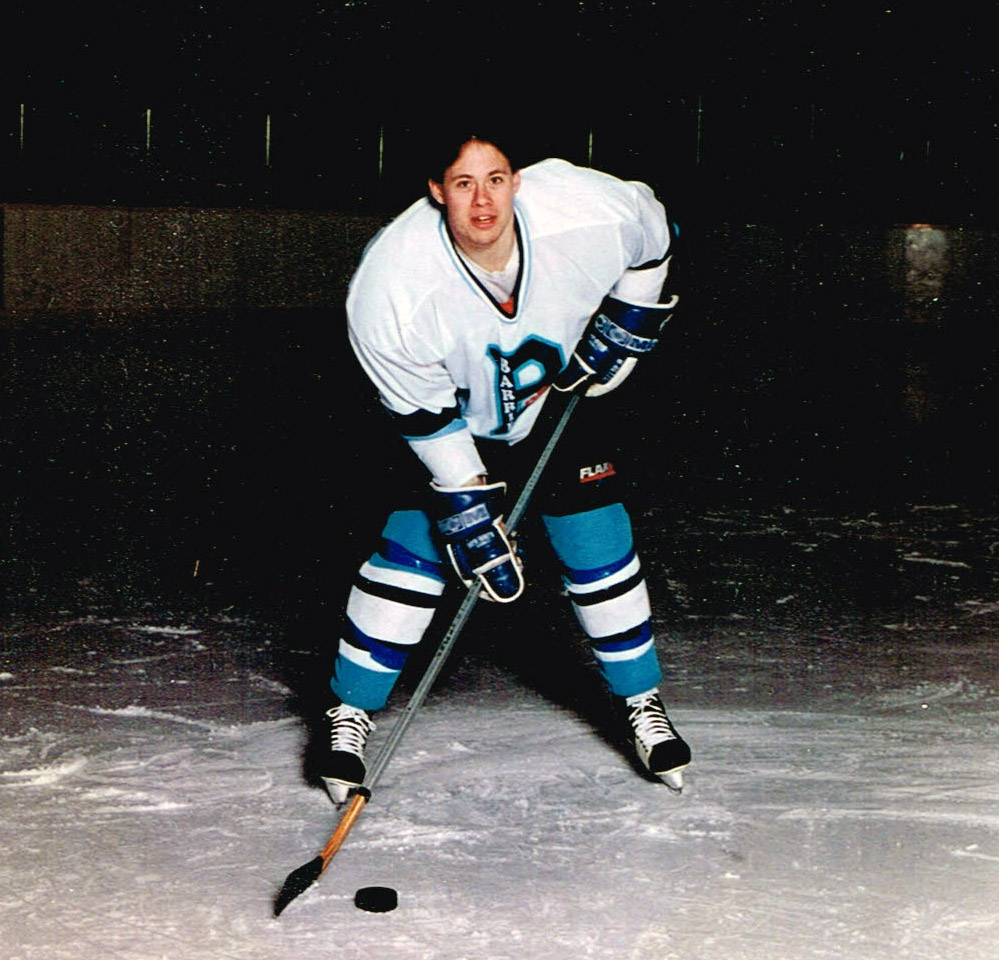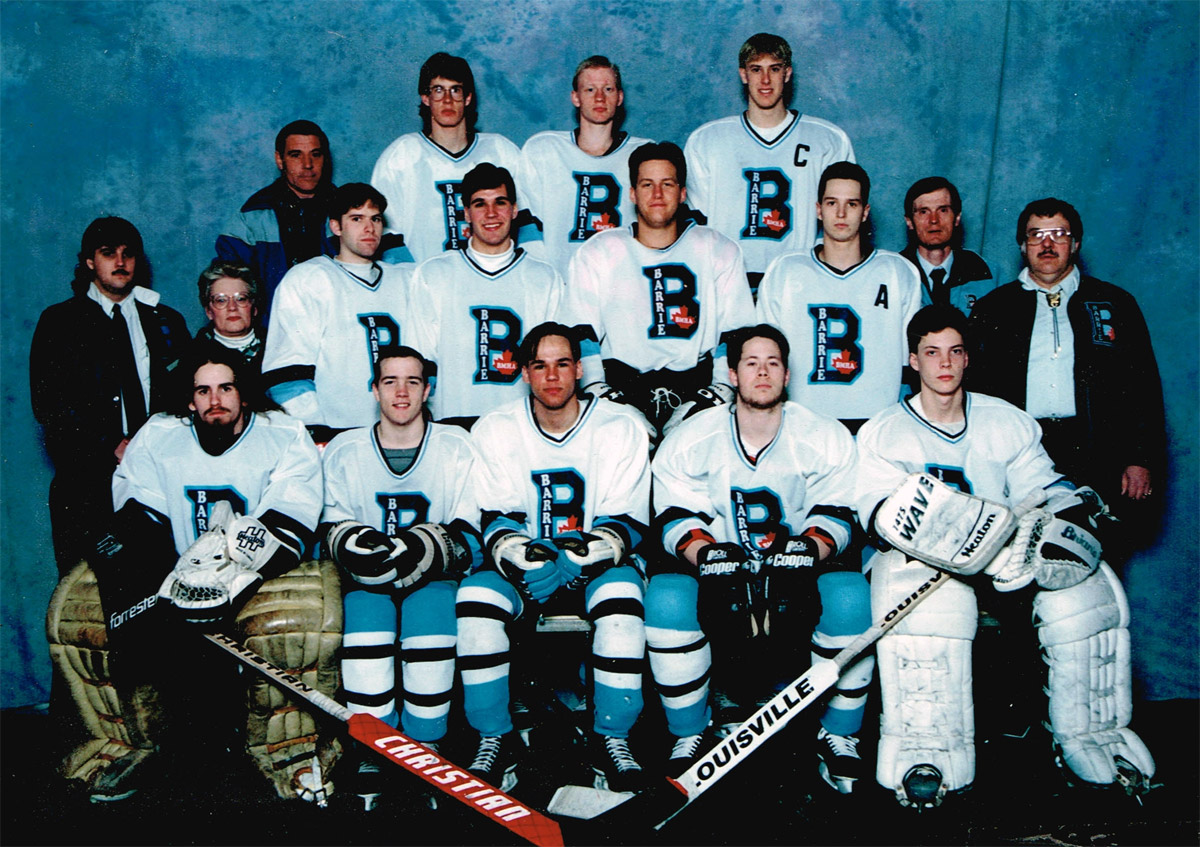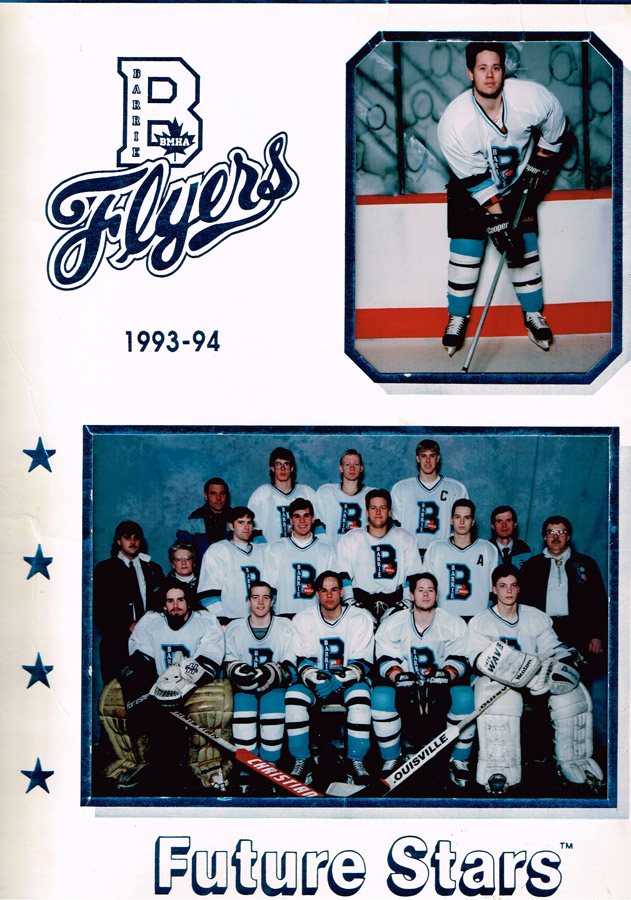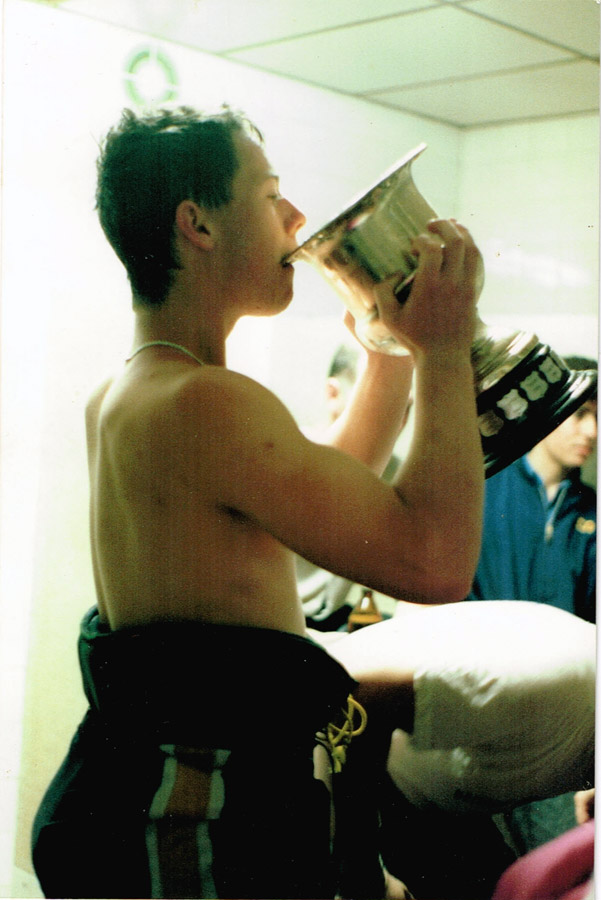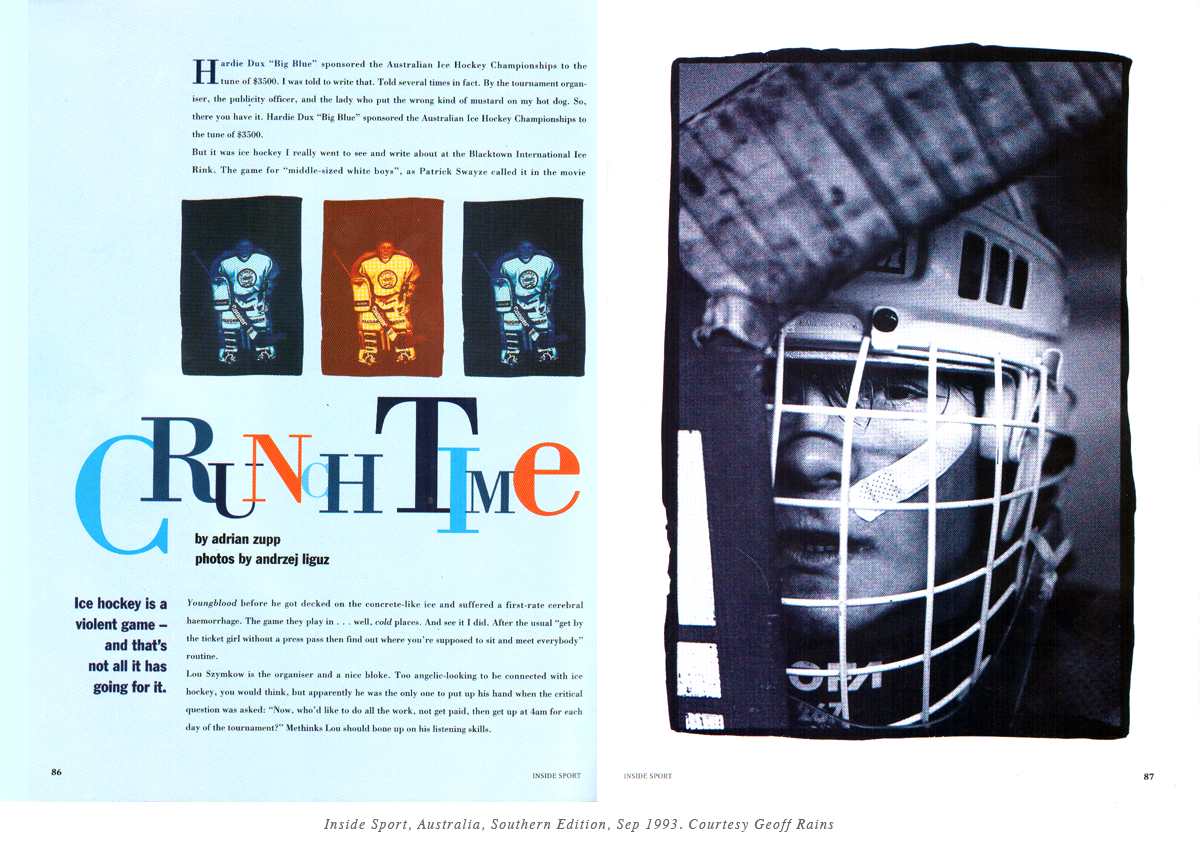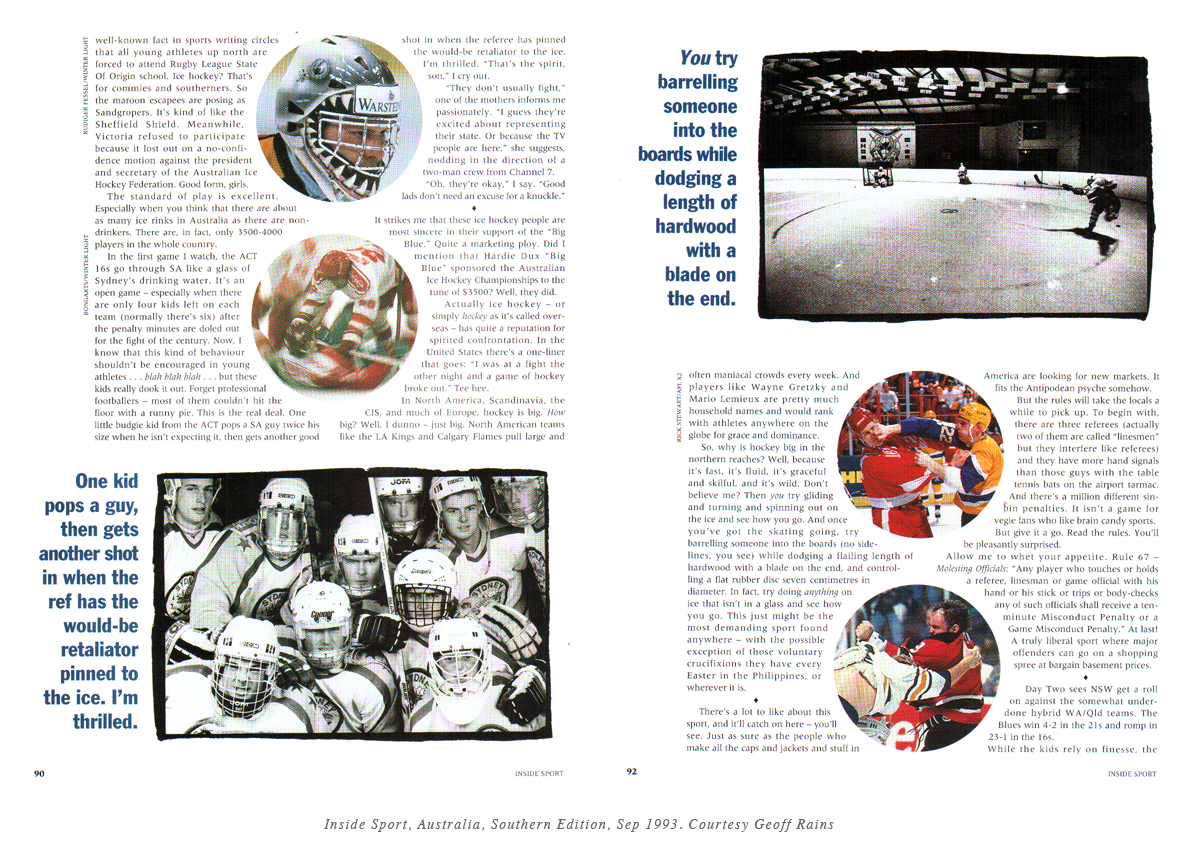
With the South Australia A-Grade Premiers, 1990.
Gunner
Geoff Rains and living the dream
Yer see, the problems associated with the playin' of ice hockey Down Under are almost too daunting to contemplate; an' for expatriate Canucks an' Septic Tanks, an' Czechs, Slovaks, Finns an' other Europeans, the frustration of watchin' their national game played incessantly at a primitive level is often too much to koala. The particular effect of this on Big Ben Ruskie was the generation of a more-or-less constant verbal analysis of the game an' all of its shortcomings as it is played Down Under. The whingeing, born of understandable frustration, an' common amongst them from Up There, had become known around the Mount as "Ben's Disease" — otherwise called verbal diarrhoea.
— Ray Rains, Hockey Night Down Under, 1991. [5]
The Barrie Colts are pleased to invite you to attend our training camp to be held late August 1992. Every major US and most Canadian universities scout our games on a regular basis. At present we have graduates of our program at the following universities; St Lawrence, Cornell, Northeastern, Miami of Ohio, Lake Superior State, and Colgate. In the season just concluded, players on our team have been offered scholarships to Michigan, Western Michigan (2), Notre Dame, and Union. In addition, it is projected that at least one will be selected in the upcoming NHL draft. We invite you to become part of this tradition.
— Alec A. Ovenden, General Manager - Coach, Barrie Colts, 1992 [7]
 1984 President's Cup — Left to right, David Brown, Corey Smith, Geoff Rains
1984 President's Cup — Left to right, David Brown, Corey Smith, Geoff Rains
THE TEMPERATURE AT SNOWDOME ADELAIDE in the 1980s was a steady plus-five, cold enough to keep the rows of real cut pines fresh and standing to attention along the edge. But there was nothing real about the two hundred tons of snow covering the one-hundred-and-fifty metre long indoor ski slope, along which hurtled skiers, toboggans and snowboarders to some uncertain fate. Overlooking this and the two ice rinks was the Alpine restaurant, the only warm place in the building. Flames from a chalet-style open fire danced across the trophies shining on the walls, re-kindling each blaze of glory, each triumph, each flickering piece of silverware. The most polished of these were the five won by South Australia in national competition — two Goodall for national senior champions, Defris for national Under-16 champions, and two President's for pee wee titles. I was standing on sacred ground, the very unofficial citadel of South Australian ice hockey.
It was here in the city of Adelaide in 1964 that South Australian ice hockey had begun — in a tiny rink upstairs in Hindley Street, measuring just 32m x 12m. About five of those will fit inside a competition ice rink, a fact that never fails to pique my curiosity, never fails to send me searching for a calculator to unravel the mystery physics of fitting two 6-man teams and officials on a pad that size. But the math is fairly simple. The first crow-eaters to ever dump a puck played three-on-three, and this continued on, buoyed by Canadian expats in NHL jerseys, until new competition-sized rinks opened around the early-eighties, first at Payneham, then the Snowdome at Thebarton.
The mostly overseas-born players of the eighties state senior team had arrived for the collapsed National Ice Hockey League and stayed on, winning the televised Slapshot 83 tournament in Sydney. The state association president at that time was Canadian, Mark Weber, who later became a founder and president of, rather ironically, the Melbourne Ice (2002-'06) and a director of the newly-formed Australian Ice Hockey League. The Australian state in which Weber first officiated was no stranger to defeat. South Australia had not won a single national until the 1986 Goodall Cup. The urge to import talent must have been irresistible, yet there was more to these state teams than met the eye. Something else was also afoot.
Geoff Rains was born September 24th 1974 at St Michael's Hospital in Toronto, Canada. His parents returned home to Adelaide a few months later. His grandfather was a Canadian engineer who survived being dropped into Normandy during the war. His brother, Jason, has the evidence in the form of a piece of his parachute. His father had travelled after he finished high school, then completed a degree at Ryerson University in Toronto where he fell in love with his future wife Peggy from Timmins, and with hockey.
The boys were raised in the Adelaide suburb of Rostrevor where they attended Morialta High. Rains enjoyed school but says he never excelled at anything. He had, however, always showed an interest in hockey at the Payneham ice rink, which was situated just around the corner from their suburb. He played hockey in winter and C-grade District Turf Cricket in summer with the Payneham Cricket Club. "It was competitive," he says, "but we weren't playing for The Ashes".
He began ice hockey as a seven year-old forward in the South Australian junior league. His brother Jason never played and in those early days the coaching came from Rusty Smith, Steve Oddy and Orville Hildebrand, plus hockey clinics run by John Botterill, Craig Campbell and Hildebrand. In 1983, he competed in the inaugural Under-13 Championship, the President's Cup, now known as the Ginsberg Trophy, which was held on home ice in Adelaide. Damien Fenton in net, Paul Nesterczuk, Corey Smith, John Oddy and he, had all pursued long careers in the sport. A girl named Belinda Hoskens made her national debut, as did future ACT women's champion, Steph Wheaton. [9] Later that year, the national association amended its constitution to prohibit mixed gendered competitions, although some girls continued to play with boys.
The home team had a big advantage in national ice hockey tournaments, and they still do. It's pay to play and the cost and time involved traveling interstate for several days of competition is usually prohibitive for many, but this time Western Australia won the Adelaide championship. In those days, the parents of most young players were usually at the games and they often chipped-in to help with the scoring and the penalty box. Rains' mother and father were no exception and Ray later managed the Under-18 state teams in the 1989, 1990 and 1991 Tange Trophy tournaments. However, unlike every other parent, Ray based a book on his experience; Hockey Night Down Under published in 1991.
This new wave of young South Australian players had been working on their game since the inaugural President's Cup in Adelaide in 1983. They were coached first by Canadian expat, Orville Hildebrand, then locals Steve Oddy and Rusty Smith. In 1985, the state keeper, Damian Holland, was selected for the 1986 National Senior Team at the age of sixteen, "Just a kid playing with men!" Spectacular between the pipes in Spain, he was invited to Toronto for a goalie camp. He went on to play in the Canadian junior system and later played college hockey (NCAA) in the USA for several years where he completed a degree at the University of Illinois (1989-92).
Holland's success had a profound effect on the aspirations of some young local players and their parents. He really had "lived the dream". Although a group of young Victorians, including Jon Moses, then dominated the Under-13, Under-15 and Under-18 championships, Rains and the South Australian Under-13 Pee Wees broke through in 1987 to win the state's second national. They snatched victory from NSW, 5-3, in the final game of the four-day tournament on the undersized Oakleigh rink in Melbourne. Rains was Captain and top point scorer, one of four young players who had competed in the state's first Under-13 team five years earlier.
"SA still top in ice hockey," bellowed the press headlines from the cover of the state newsletter, "SA kids rule the ice". Dean Phillips, the team manager, said the "three days of on-ice training in Bendigo without doubt provided us with the opportunity to win the tournament. It enabled the players to tune into their new coach and come together as a team unit". [1] Thebarton Ice Arena was closed for construction of the world's first artificial ski slope, forcing the South Australians to train at Bendigo. The eight stitches in Rains' leg from a BMX accident were not re-stitched when they burst, taking weeks to heal.
Despite having coached them himself in previous years, Rusty Smith attributed the success of his kids to the newest overseas resident from British Columbia, Gordie Cochrane, the brother of the famed former NHL enforcer, Glen Cochrane. "He taught us to play as a team and systems," says Rains but it is also true he had God-like status among the young players he coached. Gord was appointed Assistant Coach of the 1988 National Youth Team and spent the next thirty years coaching both here and abroad in some of Canada’s best leagues, including a stint as Assistant Coach of the Adelaide Adrenaline in 2016. The state Pee Wees won again in 1988 and kept on winning as they rose through the national development system.
If Cochrane taught them teamwork and systems, then Redwings MVP, Kent Adair, taught them conditioning. They won the state's first Defris in 1989 (U15) with Rains as Alternate Captain, top scorer, and a first line All-Star. They won the first Tange in 1990 (U18), coached by Glen Foll and Mike McGinn, which they repeated in 1991. "Foll was a good coach," says Rains, "but by the Brown tournament (U21) the coach was just opening the gate. The guys had been together so long we just needed someone to steady the ship every now and then. We learnt from each other growing up, more than anyone in particular". Yet, it was not as easy as all that.
"I had another dream later that same night ... of the Tange Tournament," wrote his journalist father. "It was a real bloody nightmare. I saw the super skaters of the eastern states bearin' down on a defenceless Bottler, pepperin' him with rocketin' pucks that he didn't see or hear 'til they dropped from the netting behind his skates with a sickening clunk that signals another goal. I saw the ice littered with the bodies of South Australia's young but hapless hockey knights an' the scoreboard showin' Opposition 10, South Oz 0. I saw Kirk, our best player, shootin' for what would be our only goal of the tourney an' woke up, in a sweat, shoutin' "NAA!..." as Kirk's shot whistled wide."
It was this terrifying image, humiliation at the hands of the Eastern States, that led Rains' father to become team manager of the 1989 State Tange squad. [6] The state had never won the tournament and the junior committee were struggling to put together a full squad of players for this one, which was eventually won by the ACT. In 1990, Rains was one of the youngest players with the National Youth Team (U18) competing in the Asian-Oceanic Championships in Seoul, South Korea.
"I swear the officials had never seen body contact in hockey before. And anytime they heard 'f**k' we got a penalty. Bench minors, unsportsmanlike misconducts, you name it." The Japan juniors were in a league of their own with players like Hiroyuki Miura, a Montreal 11th-round pick in 1992, and the first Japanese player in the NHL, although he never played. Their coach, Toshimitsu Ohtsubo, had been Japan's backup keeper in the 1967 C-Pool Worlds in Vienna, then No 1 in the B-Pool Worlds in '74 and '75.
Rains considered Mark Macgregor a great guy and coach, but unfortunately he did not travel with the team. The squad was coached by Mannly Dubroy who had put up a point a game playing pro with the Kenora Huskies in the MJHL in 1971 and '72. After graduating from Uni, Dubroy decided to travel overseas and explore job opportunities that suited his skill-set. He arrived in Australia early-1989, where he was appointed programming director of the national association and Coach of the Australian National Youth Team (NYT). Dubroy remained here, following similar paths to his predecessors, Jim Fuyarchuk and John Botterill.
Two-thirds of the 1990 NYT were from South Australia and the ACT, coached by Dubroy. They were picked after the national titles at the Canterbury rink in Sydney in 1989 where South Australia lost 8-3 to the ACT in the final, after drawing 5-5 in the prelim. Each National Youth Team player paid $2,500 to represent their State and country in Seoul where they competed against China, Japan and South Korea to finish fourth.
That year, Rains was playing B-grade with the Redwings when Arte Malste, Vlad Mihal and Craig Campbell of the Tigers approached his father. Later that year, he won the A-grade Premiership with his new club. Alternate captain of the state team that won the Tange Trophy (U18) in 1990 and 1991, he was top scorer in '90, runner-up in '91, and an All-Star both years. Brent Laver captained Victoria, and went on to coach Melbourne Ice in the AIHL. Canadian Jason Elliot was in net for the ACT, the young Canberra Knight who went on to a scholarship at Cornell from where he was drafted by Detroit, a third-string goalie in one of their Stanley Cup wins. In 1991, Rains won his second A-grade premiership with the Tigers.
In 1992 he was captain of the National Youth Team competing in the Asian-Oceanic Championships in Japan. He thought that squad could have finished with the Silver but it was not to be. He finished high school in 1991, spent two weeks training with the squad at the Australian Institute of Sport the following January, then flew to Japan with the National Youth Team in February. After the tournament, he flew directly from Japan to Canada and met Al Ovenden and Jim Burke on arrival, the coaches of the Barrie Colts at Dunlop Arena. The modern Colts had started out in the Mid-Ontario Junior B league, then moved to the Central Junior B Hockey League when their own had folded fourteen years earlier. They were already eliminated from the playoffs, and Rains was offered a tryout there and then.
He felt he played well enough at the Powassan Hawks camp in the NOJHL, but after the third or fourth session the coach told him, "if you want to make the team you have to show me more". He declined a tryout with the Junior A Timmins Golden Bears, and hopped the Greyhound to Sudbury for the Rayside-Balfour Canadians camp. Both teams played in the Junior-A NOJHL. The Canadians offered him a spot, but he rolled the dice, hoping to make the cut at the Barrie Colts camp, and declined.
Within a few days he had landed a job at Reggies Sandwich Factory in Barrie where he spent the summer of '92 making friends. He trained mostly on dry land, on ice once or twice a week. Dunlop Arena reputedly had the best ice in Canada at the time which was produced by Doug Moore's company, Jet Ice. It was Rains' favourite rink of all time and he laments its loss, "It's gone, it's a fire station now". He played shinny there once a week with some OHL players, minor league players, NHL-ers and college players; all Barrie boys.
The "ice man", Doug Moore, had developed his technique of purifying municipal tap water for ice-making at Maple Leaf Gardens fourteen years earlier, introducing ice re-surfacer additives to improve its look and finish. He founded Jet Ice Limited in 1979 and the next year he introduced the concept of large format custom logo stencils for in-ice advertising, which is now one of the sport's standard revenue generators. Moore's company became the official supplier of products to the NHL and he travelled the land showing rink engineers all across the country how to make longer-lasting and better quality ice. All but one NHL team still use it today. [8]
Cut late from a tryout with the Colts, when all the Junior-A and Junior-B camps were finished, he played AAA Juvenile in the Barrie Minor Hockey Association. The 1992-3 Colts never lost a regular season game that season and went on to win the Sutherland Cup Championship. For the next two seasons (1993–95), they played at the Junior A Tier II level and were granted permission to join the Ontario Hockey League as an expansion franchise, starting play during the 1995–96 season. Many of the '92 players went on to pro or college hockey, including John Madden who had a storied 14-year NHL career that included a pair of Stanley Cup wins (2000, 2003) with the New Jersey Devils and another with the Chicago Blackhawks (2010).
Madden has acknowledged Jamie Massie's contributions to his success, the Colts owner of the time, as well as coaches Alec Ovenden and Jim Burke. He had landed a hockey scholarship at the University of Michigan, turning down the Niagara Flyers who selected him in the 1992 OHL draft. He recorded eighty goals and one-hundred assists in one-hundred-and-sixty games over four years with Michigan, while leading the Wolverines to an NCAA national title in 1995-96. [4] The Junior 'B' Barrie Colts powerhouse teams of the early 1990s, owed a lot to Ovenden, Burke and Mike McCann, a former coach who had turned head scout by the time Rains had arrived.
Ovenden, GM of the Colts and a former Assistant Coach, had been Head Coach of the Barrie Minor Hockey Association for three seasons (1987-88 through 1989-90). It is said he possessed a tremendous ability to teach the game of hockey to young players and he had a reputation for having one of the keenest hockey minds in the association. His teams were always over-achievers and it was virtually the one team he had coached from 1983-84 when the boys were Minor Atoms, through to their 1989-90 Major Bantam season.
McCann, on the other hand, had given up coaching in the late-1980s to concentrate on scouting and player development. When the BMHA handed the Colts over to the group headed up by Jamie Massie in the early 1990s, McCann stayed on as the team’s head scout and continued to provide high-level players for the team. Inducted into the Barrie Sports Hall of Fame as a Builder in 2004, he had encouraged many of his players to pursue college scholarships. [3]
Rains played no hockey in Australia in 1992. In 1993-4, he went to the Cowichan Valley Capitals camp with John Oddy, but both missed out. Cut late again, when most teams had signed everyone they could, he returned to Barrie and was fortunate to be able to sign with Juvenile team once more. A couple of major injuries in the team, nine all-up during the season, created an opportunity in defense. He returned home for three months to play the Brown Trophy (U21) in July 1993, staged in conjunction with the Defris tournament at Blacktown Ice Arena in Sydney. Coached by Rusty Smith, South Australia progressed unbeaten to defeat ACT, 2-1, in the final and snare the Brown Trophy for the first time in its 29-year history.
The South Australians defeated WA, 9-1; ACT, 4-3; New South Wales, 5-1 and WA again in the semi, 7-3, before the dramatic final where John Oddy scored the first goal, and Rains the second. That pair and Chris Rurak, the tournament's top defender, were all ejected from the game for various reasons in the last ten minutes. Rains scored the winning goal, and was selected to the second-line All-Stars. Redwings goalie Damien Fenton blocked thirty-two shots and stood on his head down 5-on-3 for the last two minutes. The Territorians were represented by Mike Harrow, David Batho, Jason Thewlis, Dom Cook from the New South Wales Super League's Canberra Knights.
The win was particularly sweet for Smith who had competed for the coveted trophy twenty-seven years earlier in 1966. "Back then, Victoria and New South Wales led the way in ice hockey but since then South Australia has managed to win in every category," he told the Messenger newspaper after the win. Other South Australian players included Peifer, Mark Contrad, Peter Nichols, Mike Tye, Shane Kennedy, Roman Melis, Corey Smith, David Brown, Greg Philips and Marc Greenberg. The Team Manager was Paul Roach.
Back in Barrie, Rains resumed association hockey, filling a vacancy in defense for the season. He recalls "running into championship teams!" wherever he went in Canada, making it difficult to land a spot. Back in Australia in August 1994, he captained the successful SA Brown teams in Adelaide in 1994 and Brisbane in 1995. They won in 1995 with two lines; eleven players and a goalie. In fact, it was less than that, because they lost Simon Pike (knee) and Mitch Brindamour (10-game suspension) in the first game. The suspension was for headbutting and the tribunal had reportedly refused to look at the video, a copy of which survives.
About two weeks after Rains won the Brown Trophy in Brisbane, he won the Goodall Cup in the state squad captained by Peter Tonkin, long-time captain of the local Falcons club. He was paired in defense with Chris Rurak who won the John Nicholas Trophy, the tournament MVP. Rains had remained in defense on his return for three Goodall Cups and two Brown Trophy tournaments — '94, '95, '96.
His last state game was the 1996 Goodall Cup final loss to New South Wales in Adelaide. He had started working in stables that year and it was evident he could not do both. Over a playing career spanning fifteen years, he had played for three of the four local clubs — Redwings, Tigers, Blackhawks — winning every one of the five age-delimited national trophies. Rains was in the vanguard of local players who moved overseas to further their hockey careers.
 With the National Youth Team, Asian-Oceanic, 1990
With the National Youth Team, Asian-Oceanic, 1990

Citations
[1] President's Cup Report, Dean Phillips, South Australian Hockey News, October 1987
[2] Biographical notes of Geoff Rains, September October, 2016.
[3] Barrie Sports Hall of Fame, 1989 Nominees for Coach / Team Official of the Year
[4] The Barrie Examiner, October 1, 2013, "Former Junior 'B' Barrie Colts star's career took him through New Jersey, Chicago, Minnesota and Florida", by Gene Pereira.
[5] Hockey Night Down Under, Ray Rains, 1991, R + R Down Under, Out of print. Kindle e-book ($6.40) online
[6] Op Cit, p 28.
[7] Letter from Alec Ovenden, Barrie Colts, to Geoff Rains, June 4, 1992
[8] The Ryersonian, April 1 2015, "Doug Moore: the ice man who warmed hearts," by Ryan Skilton.
[9] 1983 President's Cup program, South Australian Ice Hockey Association, May 13th- 15th, 1983.
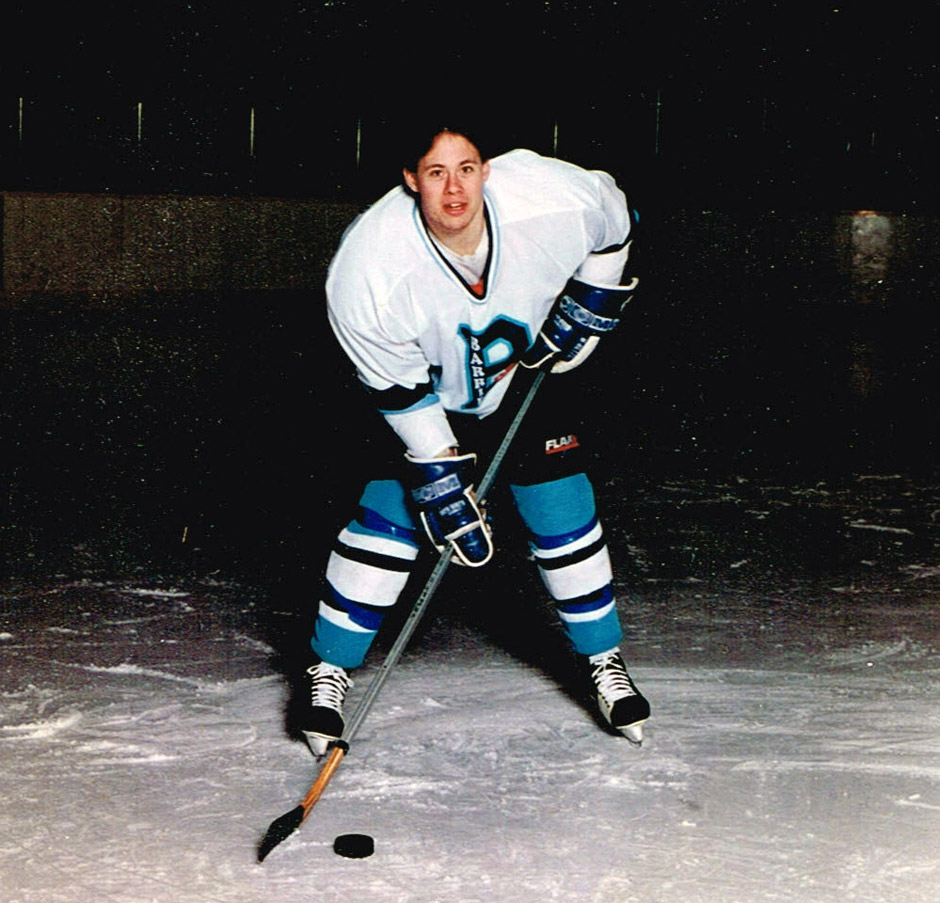
Living the dream: Rains playing in Canada, 1992




